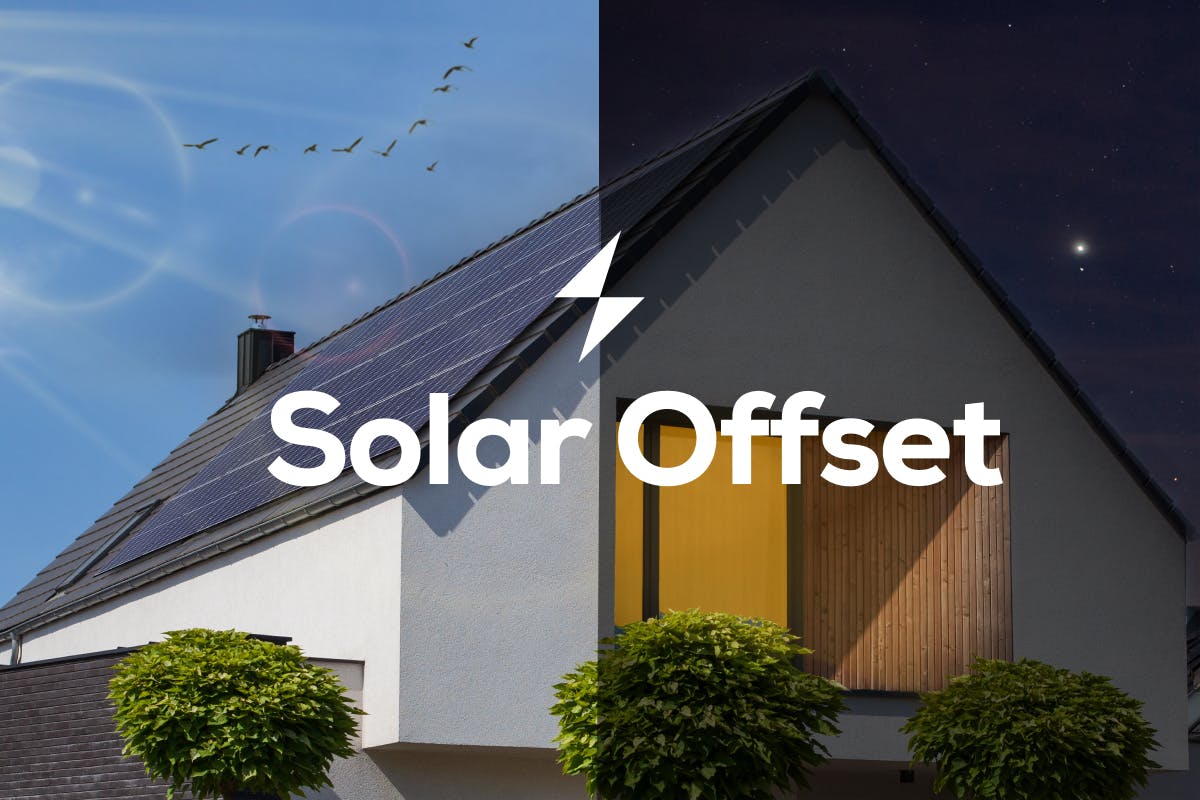One of the biggest reasons most people install solar panels on their homes is to save money. Solar offset measures the amount of energy you produce, compared to the amount of energy you consume. You might assume that offsetting 100% of your energy needs with solar power is the way to maximize your savings, but it’s more complicated than that.
When you use electricity from your solar energy system instead of the electric grid, you cut down on your monthly electricity bill from the utility. However, there are times when you produce more electricity than you need. There are other times when the amount of energy your solar panels create is less than the amount of energy you currently need to use. When measured over a year, these competing amounts of electricity from both your solar panels and the grid introduces a concept called solar offset.
This article will explain what solar offset means, how to calculate it for yourself, what the ideal solar offset is, and how to use the concept to lower your monthly energy expenses.
See how much you can save by going solar with Palmetto
Solar Offset Definition
Solar offset is a measurement of the yearly difference between the amount of electricity generated by your solar panels, and the amount of electricity your home uses. It’s typically expressed as a percentage.
In a perfect scenario, your home would use the same amount of electricity as your solar panels generate, but realistically, it’s never going to be exactly 100%. However, you can still design a system that gets as close to 100% as possible, based on your historic energy consumption habits.
Consider this more likely scenario:
- For some months (usually in the winter), your home uses more electricity than your solar panels generate. This means you have to draw power from the electric grid.
- In other months (usually in the summer), you generate excess solar energy that your home can’t use. You can either send that electricity back to the electric grid or store it in solar batteries.
Thus, solar offset is a way to measure this imbalance so you can have a better idea of what your electricity production and consumption might be.
How to Calculate Solar Energy Offset
The basic equation is simple:
Amount of Yearly Solar Electricity Generated in Kilowatt-Hours (kWh) / Amount of Yearly Electricity Consumed in Kilowatt-Hours (kWh) = Solar Energy Offset.
Once you do this calculation, you can convert the answer into a percentage by multiplying it by 100. For example: 1 = 100%, .5 = 50%, and 1.5 = 150%
Stated another way, the “perfect” solar energy offset is 1, or 100%. As in, your home used the same amount of electricity over a year as your solar panels generated.
Here is an example:
- Your solar panels generated 9,420 kilowatt-hours (kWh) of electricity in a year.
- Your home used 8,640 kWh in a year.
- 9,420 kWh / 8,640 kWh = A solar offset of 1.090, or 109%.
It’s easy to do those calculations with historical information. If you already have solar panels installed, you know how much electricity usage your home used and how much electricity your solar panels generated. The tricky part comes when you don’t have solar panels on your roof and want to predict how many solar panels you need to install to achieve a desired solar offset.
How Much Solar Power Offset Do I Need?
Homeowners often want to install enough solar panels to lower their utility bills as much as possible. You might think that by designing a solar power system with a solar power offset of 100%, you could eliminate your electric bill from the utility (aside from charges like fixed fees that you will always pay to remain connected to the grid).
However, because of the way that net metering works in many areas, offset solar of 100% could still mean that you owe the utility for some of the power that you used. Because solar offset measures the balance of production and consumption over a year, it doesn’t take into account the amount you pay for power from the utility or the amount of credit you get for net metering.
To simplify this explanation, imagine that you need 20 units of electricity each month, and there are only 2 seasons: winter and summer.
In the summer months, sunny days mean that your solar panels generate 30 units of electricity. Since you only need 20 units, you can give the extra 10 units back to the grid and get credit for them. However, the grid might only credit you at a 50% rate, so the 10 units you give back earn you only 5 credits.
In the winter months, the darker days mean that your solar panels only generate 10 units of electricity. You have 5 credits per month from the summer, and you generate 10 units (for a total of 15 units) but you still need 20 units. Therefore, you still have to buy 5 units from the utility.
Your solar offset is 100% because you consumed 240 units (12 months x 20 units) and you produced 240 units ((6 months x 10 units) + (6 months x 30 units)). However, you still had to buy 30 units from the utility (6 months x 5 units) to meet your needs.
As a result, we sometimes recommend a solar offset that is more than 100% to maximize savings. In some cases, we may recommend a solar offset that is less than 100% because this will allow you to save more money overall. It all depends on the cost of solar, the net metering policy of your local utility company, and other factors.
Factors That Impact Solar Panel Offset
When estimating solar panel offset, it can be difficult to predict an exact percentage, because you are using historical data and assumptions about the future. These estimates can be impacted by a variety of factors:
- Roof Size: The size of your roof can limit the number of panels that can be installed.
- Solar Seasonality: The amount of sunlight your roof receives during the year can limit how much electricity your panels can generate.
- Utility Regulations: Utilities can restrict the amount of offset a system is designed to provide.
- Battery Storage: If you can save your excess solar generation from the daytime, you can use that electricity at night when your solar panels aren’t producing power, which changes how you use net metering.
It can also be difficult to achieve a desired solar offset, depending on how much energy you use and how much you can potentially produce. Let’s examine these factors in closer detail:
Roof Size and Type
If you have a home with a flat roof, you likely have less space for solar panels than a home with a pitched roof that has more surface area for installing more solar panels at the optimum angle.
If your roof doesn't have enough space for the solar panels you’d need to reach your desired solar offset, you may need to pursue other options like solar batteries in hopes of storing your excess power generation.
See how much you can save by going solar with Palmetto
Amount of Sunlight and Seasonality
Your solar panels won't provide energy for you at night or on a cloudy day. As the seasons change, the amount of sunlight your panels receive will change as well. As a result, the weather can either limit or boost the amount of electricity your solar panels can produce. That change depends on where you live and can have an impact on your yearly solar offset.
Utility Company Regulations
The maximum offset of your solar energy system could be restricted by your local utility company. Each utility company has a different set of rules for what will work safely on their network. Unfortunately, you don’t have many options if your utility provider doesn’t let you achieve your desired solar offset.
Power Storage Options
Unless you turn off your entire home, you will still use energy at night, and solar panels don't create electricity in the dark. You can use net metering credits to cover that energy usage, but as we discussed, the net metering policy of your local utility company could mean that the credits don’t cover all of your expected needs.
Another option is storing your excess power because you get almost a 1-to-1 rate of power in to power out. (There is some loss from the system, but it’s minimal.) The amount of power storage you need depends on your solar offset: The lower the offset, the more energy storage you’ll need to cover the difference.
Energy Consumption Habits
Your household electricity usage changes based on things like climate, weather, use of appliances and lights, and the time of day. While you can’t control how much electricity your panels generate, you can control how much you use, so limiting your energy consumption can make it easier for your electricity production to cover your needs.
Solar Offset Is an Important Design Decision
It’s essential to consider solar offset when planning and designing your solar installation. Depending on things like your net metering rate and future energy needs, you may maximize your overall savings by having a solar offset that’s more than 100%, and sometimes you might even be better off with a solar offset of less than 100%.
You want your solar panels to take care of a majority of your home’s energy usage, but even with 100% solar offset, you might still have to buy electricity from the utility company. Depending upon certain factors, you might be able to install a system that fully meets your energy needs. You also might need add-ons like energy storage to power your home at night when solar panels don’t create electricity to maximize your savings.
Achieving the correct offset for solar requires a careful combination of solar system size, net metering considerations, battery storage, and other factors. It also requires homeowners to control their usage carefully through energy-efficient habits and behaviors, smart appliances, efficient lighting, and other means.
If you're ready to install solar panels to help offset your energy costs and switch to clean, renewable energy, you can get started with our Free Solar Design and Savings Estimate Tool to see how much you can save by going solar.
See what solar can do for you:
 Cory O'BrienSenior Director - Growth Marketing
Cory O'BrienSenior Director - Growth MarketingCory brings over 8 years of solar expertise to Palmetto, and enjoys sharing that knowledge with others looking to improve their carbon footprint. A dog lover residing in Asheville, NC with his wife, Cory graduated from UCSB. If you run into him, ask him about the company he founded to rate and review beer!

